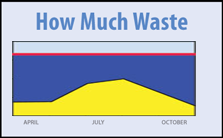Largest, Most Distant Water Reservoir
Two teams of astronomers have discovered the largest and farthest reservoir of water ever detected in the universe.
The water, equivalent to 140 trillion times all the water in the world's oceans, surrounds a huge, feeding black hole, called a quasar, more than 12 billion light years away.
"The environment around this quasar is very unique in that it's producing this huge mass of water," said Matt Bradford, a scientist at NASA's Jet Propulsion Laboratory in Pasadena, California. "It's another demonstration that water is pervasive throughout the universe, even at the very earliest times."
Bradford leads one of the teams that made the discovery. His team's research is partially funded by NASA and appears in the Astrophysical Journal Letters.
A quasar is powered by an enormous black hole that steadily consumes a surrounding disk of gas and dust. As it eats, the quasar spews out huge amounts of energy. Astronomers expected water vapour to be present even in the early, distant universe, but had not detected it this far away before.
There's water in the Milky Way, although the total amount is 4,000 times less than in the quasar, because most of the Milky Way's water is frozen ice.
Water vapour is an important trace gas that reveals the nature of the quasar. In this particular quasar, the water vapour is distributed around the black hole in a gaseous region spanning hundreds of light years in size (a light year is about six trillion miles).
The presence indicates that the quasar is bathing the gas in X-rays and infrared radiation, and that the gas is unusually warm and dense by astronomical standards. Although the gas is at a chilly minus 63 degrees Fahrenheit (minus 53 degrees Celsius) and is 300 trillion times less dense than Earth's atmosphere, it's still 10 to 100 times denser than what's typical in galaxies like the Milky Way.
Measurements of the water vapour and of other molecules, such as carbon monoxide, suggest there is enough gas to feed the black hole until it grows to about six times its current size.


